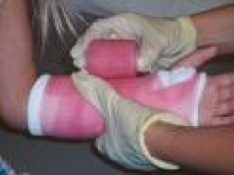If casting or splinting is part of your treatment plan, we can create these for you before you leave the office (when appropriate, "waterproof" casting is available!).
FAQs: What You Need to Know about Your Cast or Splint

What is the difference between a splint and a cast?
A splint is made of hard material, probably plaster. The hard part usually is only on one side of your arm or hand, even though the ACE/elastic bandage wraps all the way around your arm. This type of immobilization supports your arm or hand, but allows it to swell without restricting the blood flow. Generally, the splint will be changed to a cast after a few days to a few weeks, depending on the type of injury you have.
A cast is made of hard material, probably plaster or fiberglass, and the hard material goes all the way around your arm or hand. This gives more rigid support than does a splint, but has limited ability to allow your arm or fingers to swell.
Living with a Splint or Cast
First, keep your arm elevated. If your arm is below the level of your heart, it will hurt more because it will stay swollen. Keep it up at shoulder level or higher. Prop it up with a pillow when you are sitting or lying down, and hold it up when you are standing. Don't depend on a sling, because this puts your arm below the level of your heart.
How long should you hold it up? If it hurts to put it down, you still need to keep it up! Don't get too frustrated; usually, you usually only need to do this for two to three days.
It takes about 48 hours for the splint or cast material to fully dry and harden. Treat it gently.
Don't let the splint or cast get wet. Plaster splint material will soften and not harden again. In addition, the cotton padding will not dry fully and your skin will get injured. You can purchase a pre-made cast protector, or try a newspaper bag and a rubber band! If you have a waterproof cast, you can shower or swim in it.
Don't scratch under the splint or cast. You might get a skin infection or an ulcer (I have recovered quarters, even venetian blinds, from under casts...and it wasn’t pretty!).
Don't pick at the cast padding. It will pull out from inside the splint or cast and then the cast will not be padded enough to protect you.
Don't trim or alter the splint or cast. If an edge is uncomfortable, try padding it with moleskin (foot care section of the drugstore) or some duct or medical tape. If it remains uncomfortable, please call the office so that you can come in for cast repair.
Fractures are painful injuries, so unfortunately, you can expect it to be somewhat uncomfortable. Resting your arm, elevation, ice, and acetaminophen (Tylenol) are usually all that are needed. Prescription pain medication is rarely needed. If your hand or arm become too painful, please call the office.
It is possible that your hand or arm could swell inside the cast or splint, and it could become too tight. This is extremely rare, and keeping your arm elevated above the level of the heart usually prevents this. A splint can be unwrapped, the cotton split (to loosen the fit), and rewrapped. The best way to tell if the cast needs to be loosened is if the cast feels too tight and you begin to notice progressive numbness (numbness that starts and gets worse) in the fingers. If this happens, please call the office right away.
Be careful with the splint or cast. If it cracks or if you have any other issues described above, please call the office at (248) 663-1900.